FIT5145 - Business and Data Case Study: E-commerce Industry in India
VerifiedAdded on 2021/05/30
|11
|3027
|46
Project
AI Summary
This project presents a comprehensive case study of the e-commerce industry in India, examining its growth, business models, and the pivotal role of data science. It explores various e-commerce categories, including business-to-business, business-to-consumer, consumer-to-consumer, and consumer-to-business models, illustrating their interactive dynamics. The study highlights the importance of data characteristics such as volume, variety, velocity, and variability in shaping business strategies. It also addresses the challenges and opportunities in data analysis, emphasizing the use of tools like Hadoop, Spark, and Apache Flink for efficient data processing and visualization. The project further explains the value of e-commerce, including increased accessibility, wider market reach, and improved customer engagement. It provides insights into customer touchpoints, customer lifetime value modeling, and churn prediction, underscoring the significance of data-driven decision-making for business success in the competitive e-commerce landscape. The project also includes an interactive e-commerce model that visually represents the relationships between businesses, wholesalers, retailers, products, and customers, providing a clear framework for understanding e-commerce operations. The case study also mentions the importance of internet accessibility in India, the challenges faced by the e-commerce model, and the tools for data analysis.
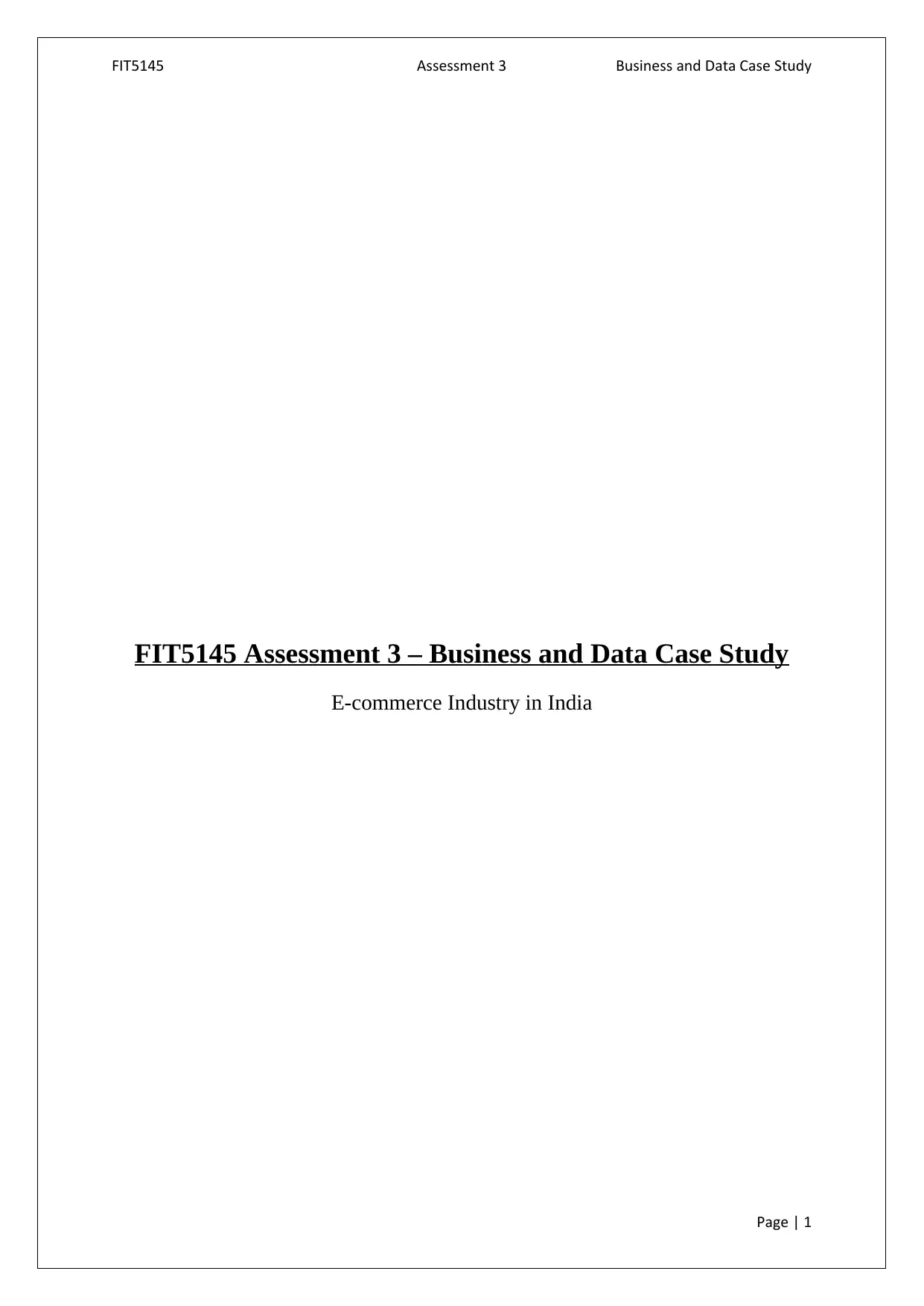
FIT5145 Assessment 3 Business and Data Case Study
FIT5145 Assessment 3 – Business and Data Case Study
E-commerce Industry in India
Page | 1
FIT5145 Assessment 3 – Business and Data Case Study
E-commerce Industry in India
Page | 1
Paraphrase This Document
Need a fresh take? Get an instant paraphrase of this document with our AI Paraphraser
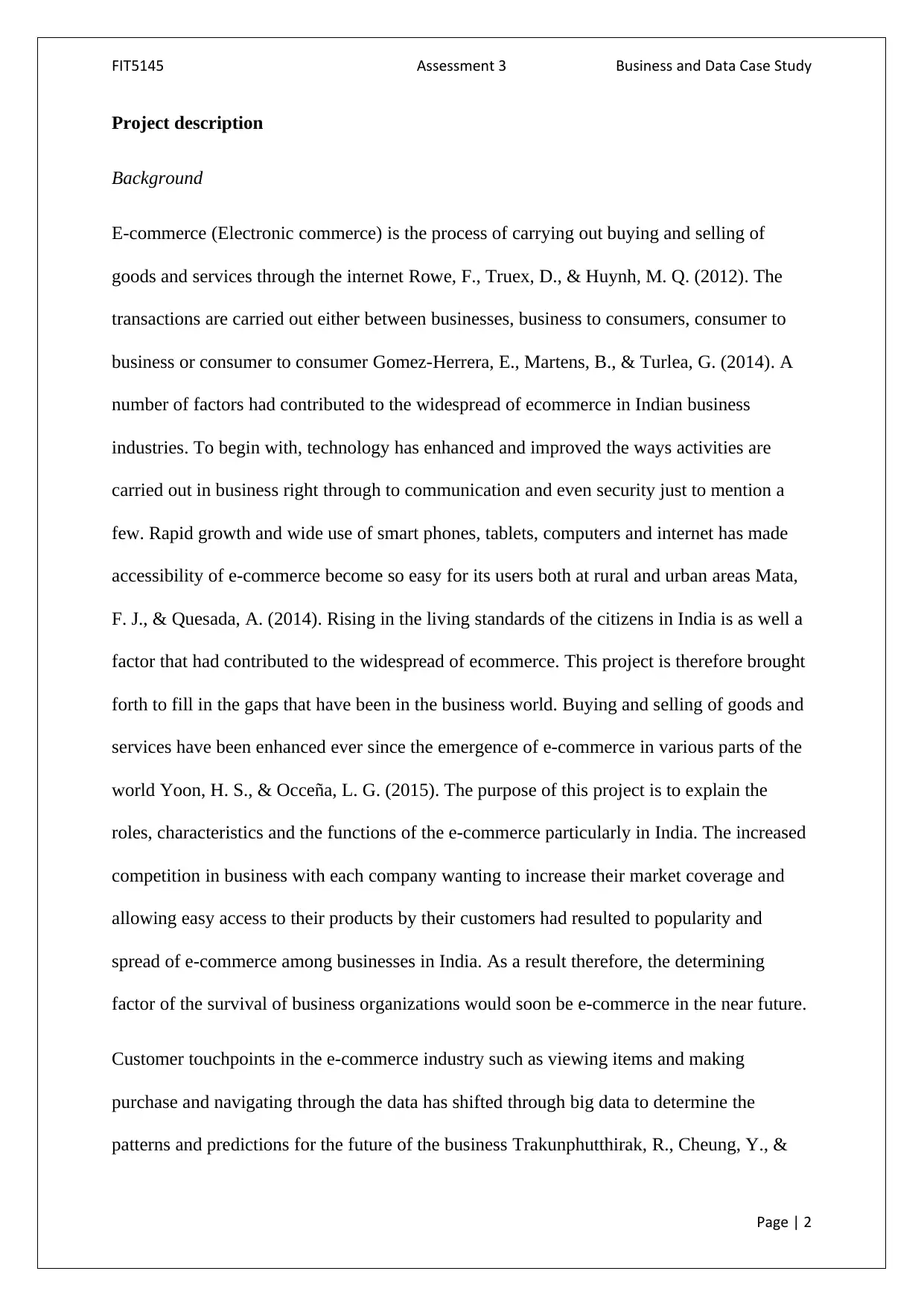
FIT5145 Assessment 3 Business and Data Case Study
Project description
Background
E-commerce (Electronic commerce) is the process of carrying out buying and selling of
goods and services through the internet Rowe, F., Truex, D., & Huynh, M. Q. (2012). The
transactions are carried out either between businesses, business to consumers, consumer to
business or consumer to consumer Gomez-Herrera, E., Martens, B., & Turlea, G. (2014). A
number of factors had contributed to the widespread of ecommerce in Indian business
industries. To begin with, technology has enhanced and improved the ways activities are
carried out in business right through to communication and even security just to mention a
few. Rapid growth and wide use of smart phones, tablets, computers and internet has made
accessibility of e-commerce become so easy for its users both at rural and urban areas Mata,
F. J., & Quesada, A. (2014). Rising in the living standards of the citizens in India is as well a
factor that had contributed to the widespread of ecommerce. This project is therefore brought
forth to fill in the gaps that have been in the business world. Buying and selling of goods and
services have been enhanced ever since the emergence of e-commerce in various parts of the
world Yoon, H. S., & Occeña, L. G. (2015). The purpose of this project is to explain the
roles, characteristics and the functions of the e-commerce particularly in India. The increased
competition in business with each company wanting to increase their market coverage and
allowing easy access to their products by their customers had resulted to popularity and
spread of e-commerce among businesses in India. As a result therefore, the determining
factor of the survival of business organizations would soon be e-commerce in the near future.
Customer touchpoints in the e-commerce industry such as viewing items and making
purchase and navigating through the data has shifted through big data to determine the
patterns and predictions for the future of the business Trakunphutthirak, R., Cheung, Y., &
Page | 2
Project description
Background
E-commerce (Electronic commerce) is the process of carrying out buying and selling of
goods and services through the internet Rowe, F., Truex, D., & Huynh, M. Q. (2012). The
transactions are carried out either between businesses, business to consumers, consumer to
business or consumer to consumer Gomez-Herrera, E., Martens, B., & Turlea, G. (2014). A
number of factors had contributed to the widespread of ecommerce in Indian business
industries. To begin with, technology has enhanced and improved the ways activities are
carried out in business right through to communication and even security just to mention a
few. Rapid growth and wide use of smart phones, tablets, computers and internet has made
accessibility of e-commerce become so easy for its users both at rural and urban areas Mata,
F. J., & Quesada, A. (2014). Rising in the living standards of the citizens in India is as well a
factor that had contributed to the widespread of ecommerce. This project is therefore brought
forth to fill in the gaps that have been in the business world. Buying and selling of goods and
services have been enhanced ever since the emergence of e-commerce in various parts of the
world Yoon, H. S., & Occeña, L. G. (2015). The purpose of this project is to explain the
roles, characteristics and the functions of the e-commerce particularly in India. The increased
competition in business with each company wanting to increase their market coverage and
allowing easy access to their products by their customers had resulted to popularity and
spread of e-commerce among businesses in India. As a result therefore, the determining
factor of the survival of business organizations would soon be e-commerce in the near future.
Customer touchpoints in the e-commerce industry such as viewing items and making
purchase and navigating through the data has shifted through big data to determine the
patterns and predictions for the future of the business Trakunphutthirak, R., Cheung, Y., &
Page | 2
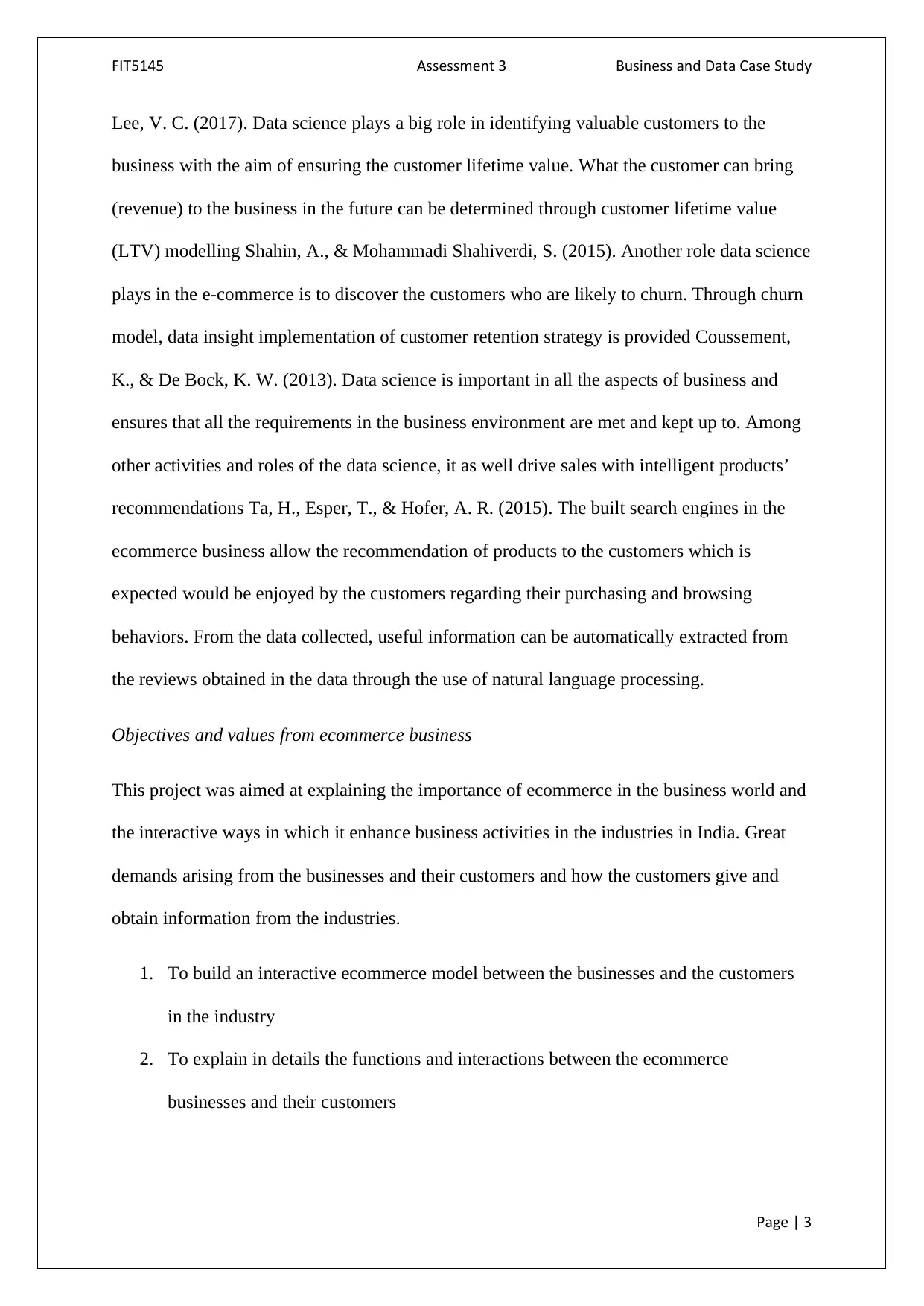
FIT5145 Assessment 3 Business and Data Case Study
Lee, V. C. (2017). Data science plays a big role in identifying valuable customers to the
business with the aim of ensuring the customer lifetime value. What the customer can bring
(revenue) to the business in the future can be determined through customer lifetime value
(LTV) modelling Shahin, A., & Mohammadi Shahiverdi, S. (2015). Another role data science
plays in the e-commerce is to discover the customers who are likely to churn. Through churn
model, data insight implementation of customer retention strategy is provided Coussement,
K., & De Bock, K. W. (2013). Data science is important in all the aspects of business and
ensures that all the requirements in the business environment are met and kept up to. Among
other activities and roles of the data science, it as well drive sales with intelligent products’
recommendations Ta, H., Esper, T., & Hofer, A. R. (2015). The built search engines in the
ecommerce business allow the recommendation of products to the customers which is
expected would be enjoyed by the customers regarding their purchasing and browsing
behaviors. From the data collected, useful information can be automatically extracted from
the reviews obtained in the data through the use of natural language processing.
Objectives and values from ecommerce business
This project was aimed at explaining the importance of ecommerce in the business world and
the interactive ways in which it enhance business activities in the industries in India. Great
demands arising from the businesses and their customers and how the customers give and
obtain information from the industries.
1. To build an interactive ecommerce model between the businesses and the customers
in the industry
2. To explain in details the functions and interactions between the ecommerce
businesses and their customers
Page | 3
Lee, V. C. (2017). Data science plays a big role in identifying valuable customers to the
business with the aim of ensuring the customer lifetime value. What the customer can bring
(revenue) to the business in the future can be determined through customer lifetime value
(LTV) modelling Shahin, A., & Mohammadi Shahiverdi, S. (2015). Another role data science
plays in the e-commerce is to discover the customers who are likely to churn. Through churn
model, data insight implementation of customer retention strategy is provided Coussement,
K., & De Bock, K. W. (2013). Data science is important in all the aspects of business and
ensures that all the requirements in the business environment are met and kept up to. Among
other activities and roles of the data science, it as well drive sales with intelligent products’
recommendations Ta, H., Esper, T., & Hofer, A. R. (2015). The built search engines in the
ecommerce business allow the recommendation of products to the customers which is
expected would be enjoyed by the customers regarding their purchasing and browsing
behaviors. From the data collected, useful information can be automatically extracted from
the reviews obtained in the data through the use of natural language processing.
Objectives and values from ecommerce business
This project was aimed at explaining the importance of ecommerce in the business world and
the interactive ways in which it enhance business activities in the industries in India. Great
demands arising from the businesses and their customers and how the customers give and
obtain information from the industries.
1. To build an interactive ecommerce model between the businesses and the customers
in the industry
2. To explain in details the functions and interactions between the ecommerce
businesses and their customers
Page | 3
⊘ This is a preview!⊘
Do you want full access?
Subscribe today to unlock all pages.

Trusted by 1+ million students worldwide
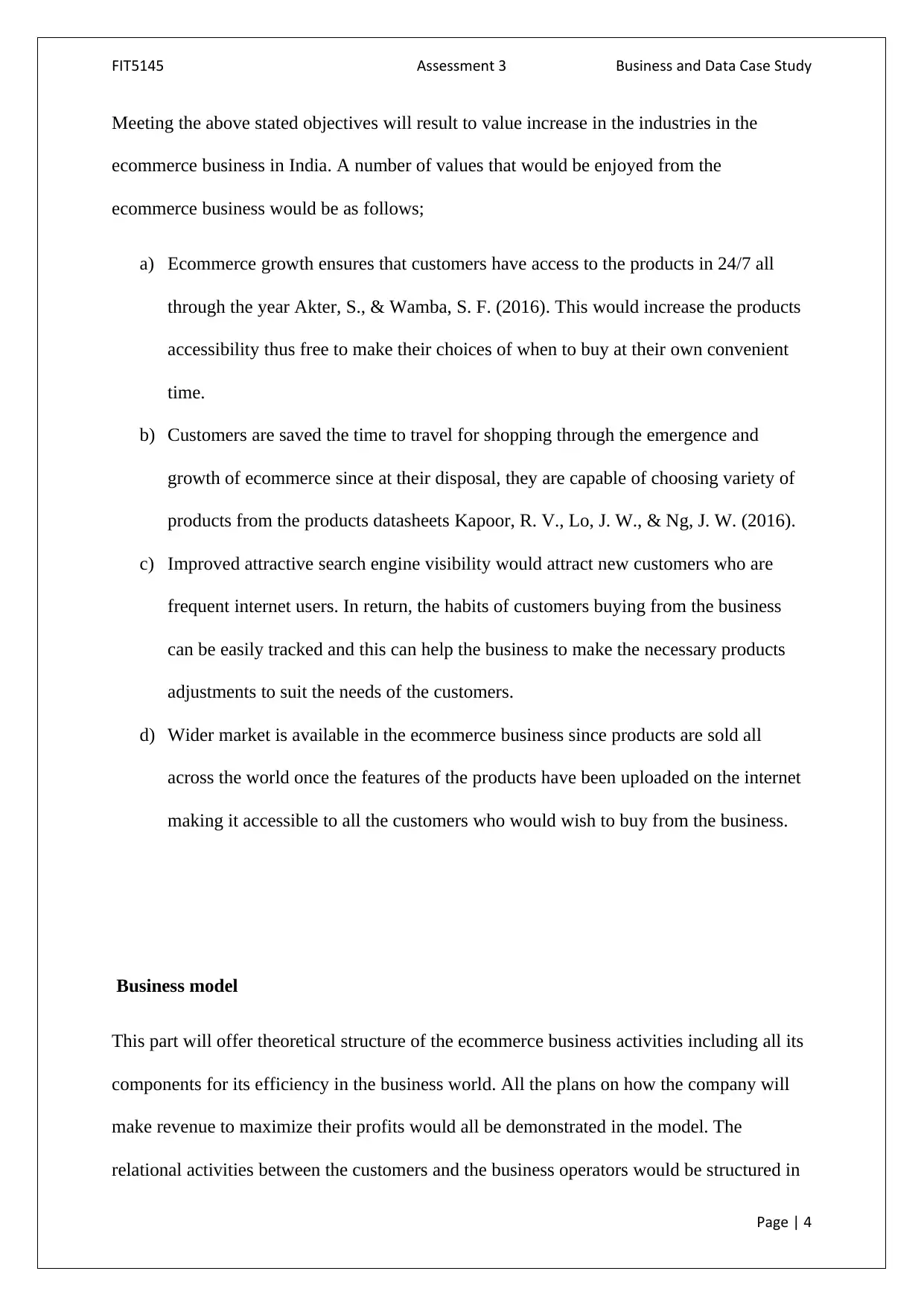
FIT5145 Assessment 3 Business and Data Case Study
Meeting the above stated objectives will result to value increase in the industries in the
ecommerce business in India. A number of values that would be enjoyed from the
ecommerce business would be as follows;
a) Ecommerce growth ensures that customers have access to the products in 24/7 all
through the year Akter, S., & Wamba, S. F. (2016). This would increase the products
accessibility thus free to make their choices of when to buy at their own convenient
time.
b) Customers are saved the time to travel for shopping through the emergence and
growth of ecommerce since at their disposal, they are capable of choosing variety of
products from the products datasheets Kapoor, R. V., Lo, J. W., & Ng, J. W. (2016).
c) Improved attractive search engine visibility would attract new customers who are
frequent internet users. In return, the habits of customers buying from the business
can be easily tracked and this can help the business to make the necessary products
adjustments to suit the needs of the customers.
d) Wider market is available in the ecommerce business since products are sold all
across the world once the features of the products have been uploaded on the internet
making it accessible to all the customers who would wish to buy from the business.
Business model
This part will offer theoretical structure of the ecommerce business activities including all its
components for its efficiency in the business world. All the plans on how the company will
make revenue to maximize their profits would all be demonstrated in the model. The
relational activities between the customers and the business operators would be structured in
Page | 4
Meeting the above stated objectives will result to value increase in the industries in the
ecommerce business in India. A number of values that would be enjoyed from the
ecommerce business would be as follows;
a) Ecommerce growth ensures that customers have access to the products in 24/7 all
through the year Akter, S., & Wamba, S. F. (2016). This would increase the products
accessibility thus free to make their choices of when to buy at their own convenient
time.
b) Customers are saved the time to travel for shopping through the emergence and
growth of ecommerce since at their disposal, they are capable of choosing variety of
products from the products datasheets Kapoor, R. V., Lo, J. W., & Ng, J. W. (2016).
c) Improved attractive search engine visibility would attract new customers who are
frequent internet users. In return, the habits of customers buying from the business
can be easily tracked and this can help the business to make the necessary products
adjustments to suit the needs of the customers.
d) Wider market is available in the ecommerce business since products are sold all
across the world once the features of the products have been uploaded on the internet
making it accessible to all the customers who would wish to buy from the business.
Business model
This part will offer theoretical structure of the ecommerce business activities including all its
components for its efficiency in the business world. All the plans on how the company will
make revenue to maximize their profits would all be demonstrated in the model. The
relational activities between the customers and the business operators would be structured in
Page | 4
Paraphrase This Document
Need a fresh take? Get an instant paraphrase of this document with our AI Paraphraser
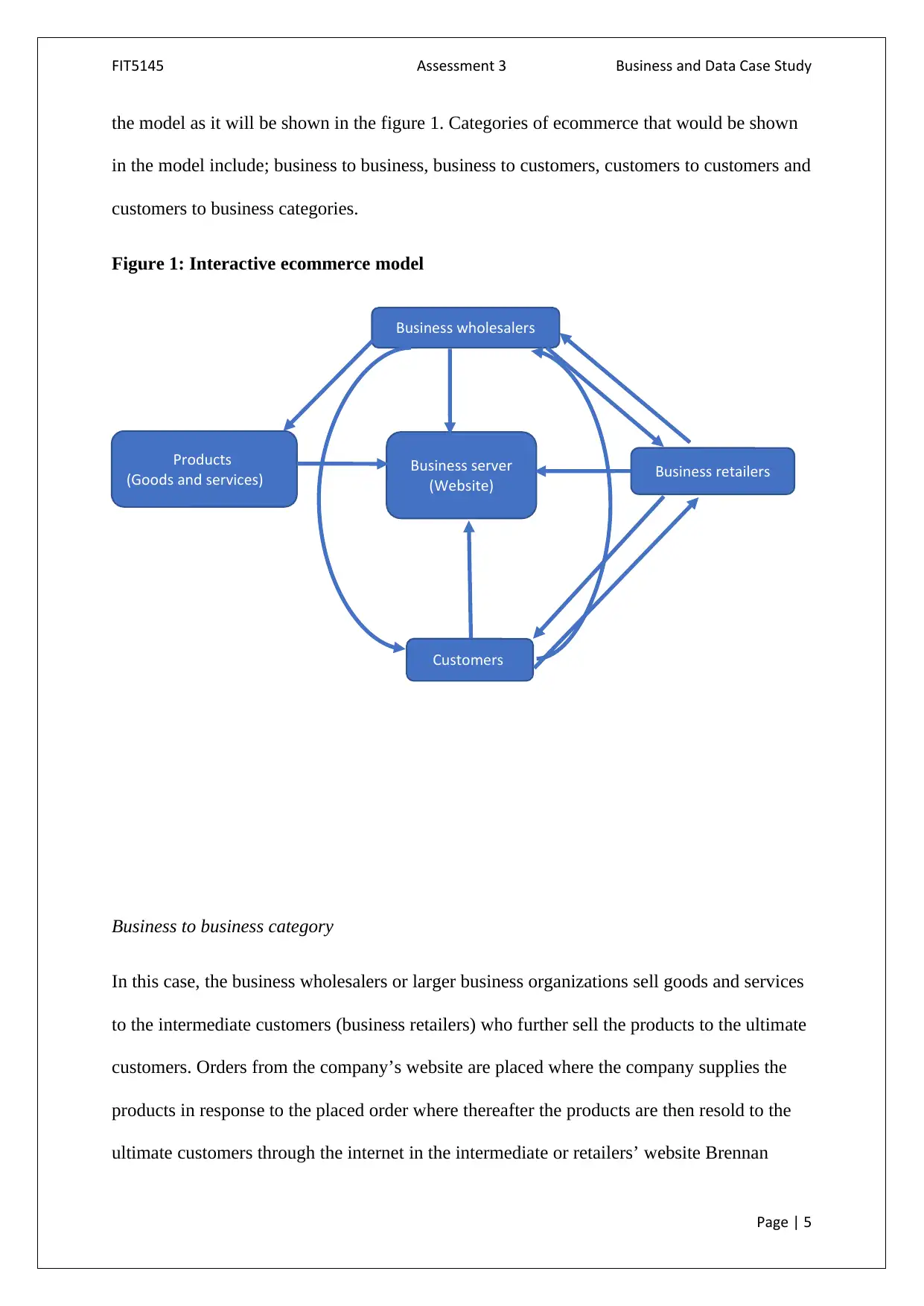
FIT5145 Assessment 3 Business and Data Case Study
the model as it will be shown in the figure 1. Categories of ecommerce that would be shown
in the model include; business to business, business to customers, customers to customers and
customers to business categories.
Figure 1: Interactive ecommerce model
Business to business category
In this case, the business wholesalers or larger business organizations sell goods and services
to the intermediate customers (business retailers) who further sell the products to the ultimate
customers. Orders from the company’s website are placed where the company supplies the
products in response to the placed order where thereafter the products are then resold to the
ultimate customers through the internet in the intermediate or retailers’ website Brennan
Page | 5
Business server
(Website)
Business wholesalers
Business retailers
Products
(Goods and services)
Customers
the model as it will be shown in the figure 1. Categories of ecommerce that would be shown
in the model include; business to business, business to customers, customers to customers and
customers to business categories.
Figure 1: Interactive ecommerce model
Business to business category
In this case, the business wholesalers or larger business organizations sell goods and services
to the intermediate customers (business retailers) who further sell the products to the ultimate
customers. Orders from the company’s website are placed where the company supplies the
products in response to the placed order where thereafter the products are then resold to the
ultimate customers through the internet in the intermediate or retailers’ website Brennan
Page | 5
Business server
(Website)
Business wholesalers
Business retailers
Products
(Goods and services)
Customers
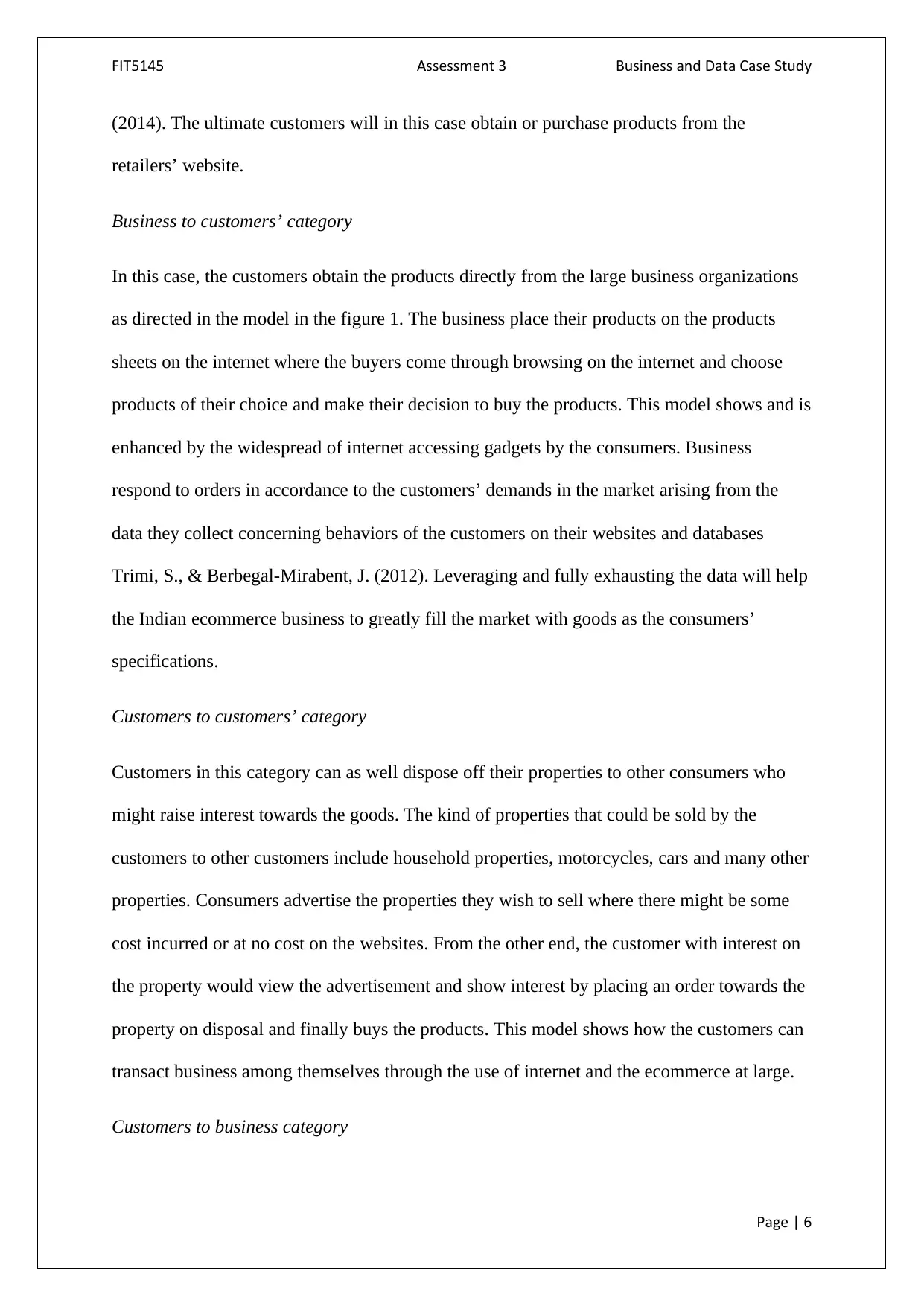
FIT5145 Assessment 3 Business and Data Case Study
(2014). The ultimate customers will in this case obtain or purchase products from the
retailers’ website.
Business to customers’ category
In this case, the customers obtain the products directly from the large business organizations
as directed in the model in the figure 1. The business place their products on the products
sheets on the internet where the buyers come through browsing on the internet and choose
products of their choice and make their decision to buy the products. This model shows and is
enhanced by the widespread of internet accessing gadgets by the consumers. Business
respond to orders in accordance to the customers’ demands in the market arising from the
data they collect concerning behaviors of the customers on their websites and databases
Trimi, S., & Berbegal-Mirabent, J. (2012). Leveraging and fully exhausting the data will help
the Indian ecommerce business to greatly fill the market with goods as the consumers’
specifications.
Customers to customers’ category
Customers in this category can as well dispose off their properties to other consumers who
might raise interest towards the goods. The kind of properties that could be sold by the
customers to other customers include household properties, motorcycles, cars and many other
properties. Consumers advertise the properties they wish to sell where there might be some
cost incurred or at no cost on the websites. From the other end, the customer with interest on
the property would view the advertisement and show interest by placing an order towards the
property on disposal and finally buys the products. This model shows how the customers can
transact business among themselves through the use of internet and the ecommerce at large.
Customers to business category
Page | 6
(2014). The ultimate customers will in this case obtain or purchase products from the
retailers’ website.
Business to customers’ category
In this case, the customers obtain the products directly from the large business organizations
as directed in the model in the figure 1. The business place their products on the products
sheets on the internet where the buyers come through browsing on the internet and choose
products of their choice and make their decision to buy the products. This model shows and is
enhanced by the widespread of internet accessing gadgets by the consumers. Business
respond to orders in accordance to the customers’ demands in the market arising from the
data they collect concerning behaviors of the customers on their websites and databases
Trimi, S., & Berbegal-Mirabent, J. (2012). Leveraging and fully exhausting the data will help
the Indian ecommerce business to greatly fill the market with goods as the consumers’
specifications.
Customers to customers’ category
Customers in this category can as well dispose off their properties to other consumers who
might raise interest towards the goods. The kind of properties that could be sold by the
customers to other customers include household properties, motorcycles, cars and many other
properties. Consumers advertise the properties they wish to sell where there might be some
cost incurred or at no cost on the websites. From the other end, the customer with interest on
the property would view the advertisement and show interest by placing an order towards the
property on disposal and finally buys the products. This model shows how the customers can
transact business among themselves through the use of internet and the ecommerce at large.
Customers to business category
Page | 6
⊘ This is a preview!⊘
Do you want full access?
Subscribe today to unlock all pages.

Trusted by 1+ million students worldwide
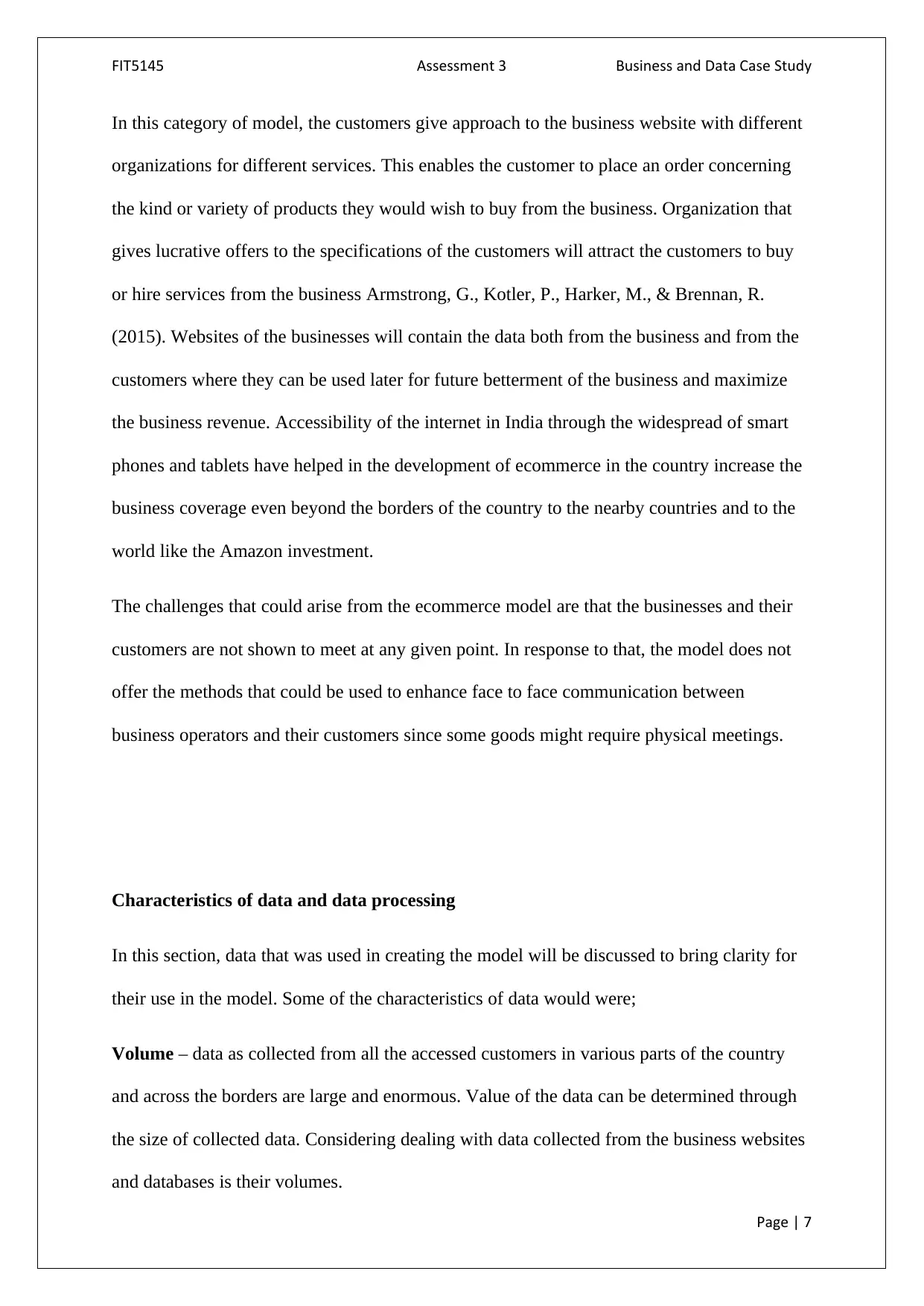
FIT5145 Assessment 3 Business and Data Case Study
In this category of model, the customers give approach to the business website with different
organizations for different services. This enables the customer to place an order concerning
the kind or variety of products they would wish to buy from the business. Organization that
gives lucrative offers to the specifications of the customers will attract the customers to buy
or hire services from the business Armstrong, G., Kotler, P., Harker, M., & Brennan, R.
(2015). Websites of the businesses will contain the data both from the business and from the
customers where they can be used later for future betterment of the business and maximize
the business revenue. Accessibility of the internet in India through the widespread of smart
phones and tablets have helped in the development of ecommerce in the country increase the
business coverage even beyond the borders of the country to the nearby countries and to the
world like the Amazon investment.
The challenges that could arise from the ecommerce model are that the businesses and their
customers are not shown to meet at any given point. In response to that, the model does not
offer the methods that could be used to enhance face to face communication between
business operators and their customers since some goods might require physical meetings.
Characteristics of data and data processing
In this section, data that was used in creating the model will be discussed to bring clarity for
their use in the model. Some of the characteristics of data would were;
Volume – data as collected from all the accessed customers in various parts of the country
and across the borders are large and enormous. Value of the data can be determined through
the size of collected data. Considering dealing with data collected from the business websites
and databases is their volumes.
Page | 7
In this category of model, the customers give approach to the business website with different
organizations for different services. This enables the customer to place an order concerning
the kind or variety of products they would wish to buy from the business. Organization that
gives lucrative offers to the specifications of the customers will attract the customers to buy
or hire services from the business Armstrong, G., Kotler, P., Harker, M., & Brennan, R.
(2015). Websites of the businesses will contain the data both from the business and from the
customers where they can be used later for future betterment of the business and maximize
the business revenue. Accessibility of the internet in India through the widespread of smart
phones and tablets have helped in the development of ecommerce in the country increase the
business coverage even beyond the borders of the country to the nearby countries and to the
world like the Amazon investment.
The challenges that could arise from the ecommerce model are that the businesses and their
customers are not shown to meet at any given point. In response to that, the model does not
offer the methods that could be used to enhance face to face communication between
business operators and their customers since some goods might require physical meetings.
Characteristics of data and data processing
In this section, data that was used in creating the model will be discussed to bring clarity for
their use in the model. Some of the characteristics of data would were;
Volume – data as collected from all the accessed customers in various parts of the country
and across the borders are large and enormous. Value of the data can be determined through
the size of collected data. Considering dealing with data collected from the business websites
and databases is their volumes.
Page | 7
Paraphrase This Document
Need a fresh take? Get an instant paraphrase of this document with our AI Paraphraser
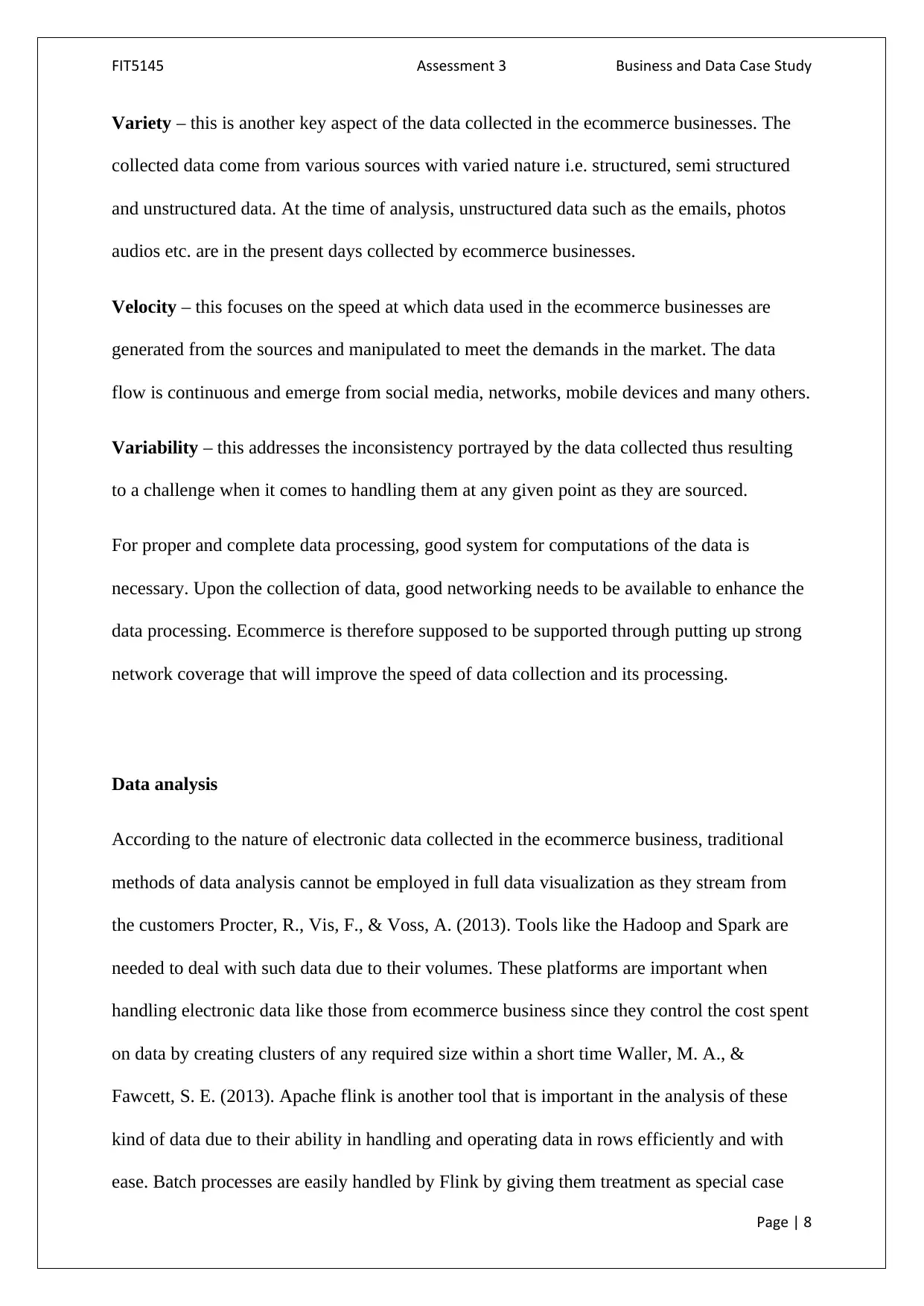
FIT5145 Assessment 3 Business and Data Case Study
Variety – this is another key aspect of the data collected in the ecommerce businesses. The
collected data come from various sources with varied nature i.e. structured, semi structured
and unstructured data. At the time of analysis, unstructured data such as the emails, photos
audios etc. are in the present days collected by ecommerce businesses.
Velocity – this focuses on the speed at which data used in the ecommerce businesses are
generated from the sources and manipulated to meet the demands in the market. The data
flow is continuous and emerge from social media, networks, mobile devices and many others.
Variability – this addresses the inconsistency portrayed by the data collected thus resulting
to a challenge when it comes to handling them at any given point as they are sourced.
For proper and complete data processing, good system for computations of the data is
necessary. Upon the collection of data, good networking needs to be available to enhance the
data processing. Ecommerce is therefore supposed to be supported through putting up strong
network coverage that will improve the speed of data collection and its processing.
Data analysis
According to the nature of electronic data collected in the ecommerce business, traditional
methods of data analysis cannot be employed in full data visualization as they stream from
the customers Procter, R., Vis, F., & Voss, A. (2013). Tools like the Hadoop and Spark are
needed to deal with such data due to their volumes. These platforms are important when
handling electronic data like those from ecommerce business since they control the cost spent
on data by creating clusters of any required size within a short time Waller, M. A., &
Fawcett, S. E. (2013). Apache flink is another tool that is important in the analysis of these
kind of data due to their ability in handling and operating data in rows efficiently and with
ease. Batch processes are easily handled by Flink by giving them treatment as special case
Page | 8
Variety – this is another key aspect of the data collected in the ecommerce businesses. The
collected data come from various sources with varied nature i.e. structured, semi structured
and unstructured data. At the time of analysis, unstructured data such as the emails, photos
audios etc. are in the present days collected by ecommerce businesses.
Velocity – this focuses on the speed at which data used in the ecommerce businesses are
generated from the sources and manipulated to meet the demands in the market. The data
flow is continuous and emerge from social media, networks, mobile devices and many others.
Variability – this addresses the inconsistency portrayed by the data collected thus resulting
to a challenge when it comes to handling them at any given point as they are sourced.
For proper and complete data processing, good system for computations of the data is
necessary. Upon the collection of data, good networking needs to be available to enhance the
data processing. Ecommerce is therefore supposed to be supported through putting up strong
network coverage that will improve the speed of data collection and its processing.
Data analysis
According to the nature of electronic data collected in the ecommerce business, traditional
methods of data analysis cannot be employed in full data visualization as they stream from
the customers Procter, R., Vis, F., & Voss, A. (2013). Tools like the Hadoop and Spark are
needed to deal with such data due to their volumes. These platforms are important when
handling electronic data like those from ecommerce business since they control the cost spent
on data by creating clusters of any required size within a short time Waller, M. A., &
Fawcett, S. E. (2013). Apache flink is another tool that is important in the analysis of these
kind of data due to their ability in handling and operating data in rows efficiently and with
ease. Batch processes are easily handled by Flink by giving them treatment as special case
Page | 8
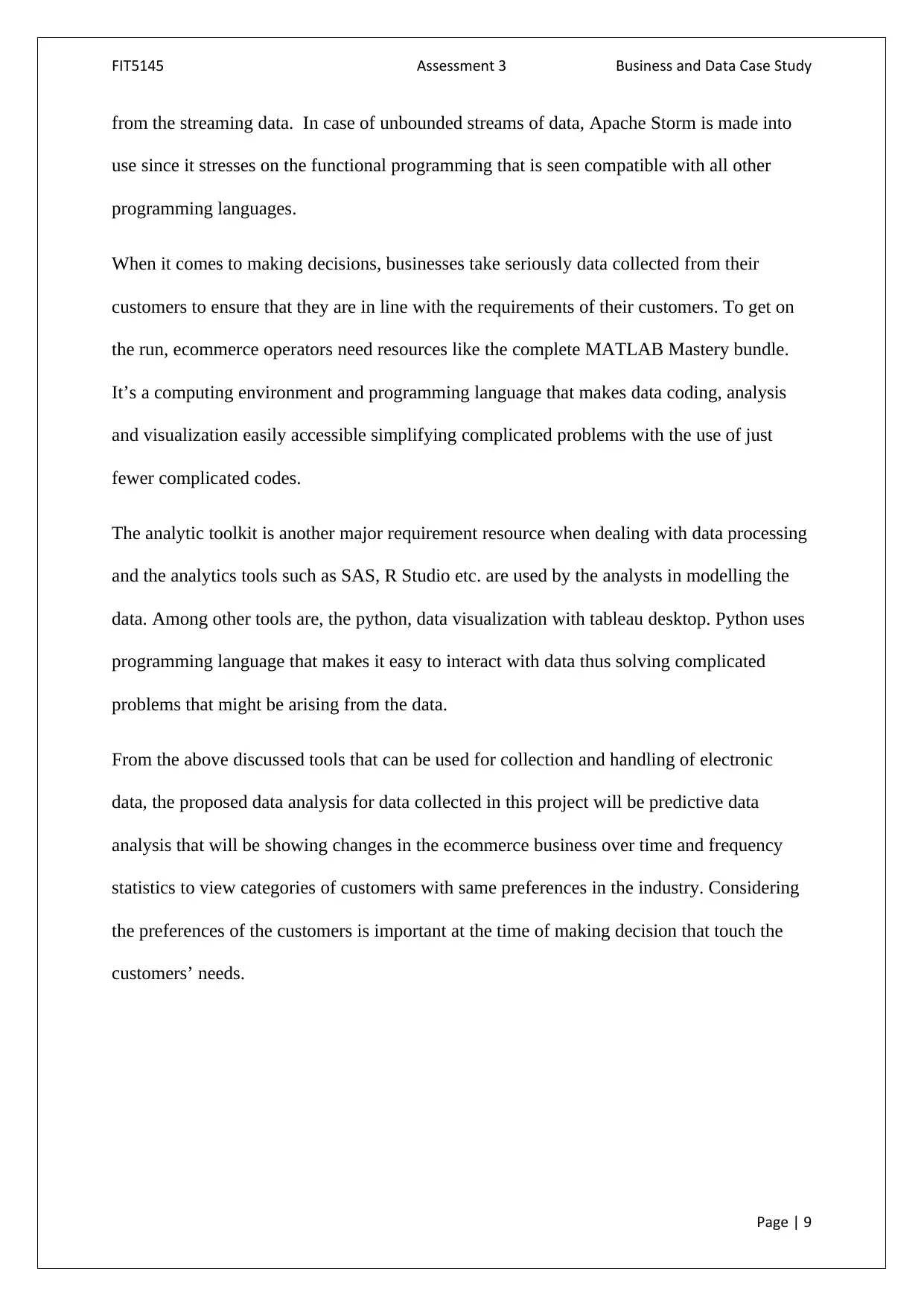
FIT5145 Assessment 3 Business and Data Case Study
from the streaming data. In case of unbounded streams of data, Apache Storm is made into
use since it stresses on the functional programming that is seen compatible with all other
programming languages.
When it comes to making decisions, businesses take seriously data collected from their
customers to ensure that they are in line with the requirements of their customers. To get on
the run, ecommerce operators need resources like the complete MATLAB Mastery bundle.
It’s a computing environment and programming language that makes data coding, analysis
and visualization easily accessible simplifying complicated problems with the use of just
fewer complicated codes.
The analytic toolkit is another major requirement resource when dealing with data processing
and the analytics tools such as SAS, R Studio etc. are used by the analysts in modelling the
data. Among other tools are, the python, data visualization with tableau desktop. Python uses
programming language that makes it easy to interact with data thus solving complicated
problems that might be arising from the data.
From the above discussed tools that can be used for collection and handling of electronic
data, the proposed data analysis for data collected in this project will be predictive data
analysis that will be showing changes in the ecommerce business over time and frequency
statistics to view categories of customers with same preferences in the industry. Considering
the preferences of the customers is important at the time of making decision that touch the
customers’ needs.
Page | 9
from the streaming data. In case of unbounded streams of data, Apache Storm is made into
use since it stresses on the functional programming that is seen compatible with all other
programming languages.
When it comes to making decisions, businesses take seriously data collected from their
customers to ensure that they are in line with the requirements of their customers. To get on
the run, ecommerce operators need resources like the complete MATLAB Mastery bundle.
It’s a computing environment and programming language that makes data coding, analysis
and visualization easily accessible simplifying complicated problems with the use of just
fewer complicated codes.
The analytic toolkit is another major requirement resource when dealing with data processing
and the analytics tools such as SAS, R Studio etc. are used by the analysts in modelling the
data. Among other tools are, the python, data visualization with tableau desktop. Python uses
programming language that makes it easy to interact with data thus solving complicated
problems that might be arising from the data.
From the above discussed tools that can be used for collection and handling of electronic
data, the proposed data analysis for data collected in this project will be predictive data
analysis that will be showing changes in the ecommerce business over time and frequency
statistics to view categories of customers with same preferences in the industry. Considering
the preferences of the customers is important at the time of making decision that touch the
customers’ needs.
Page | 9
⊘ This is a preview!⊘
Do you want full access?
Subscribe today to unlock all pages.

Trusted by 1+ million students worldwide
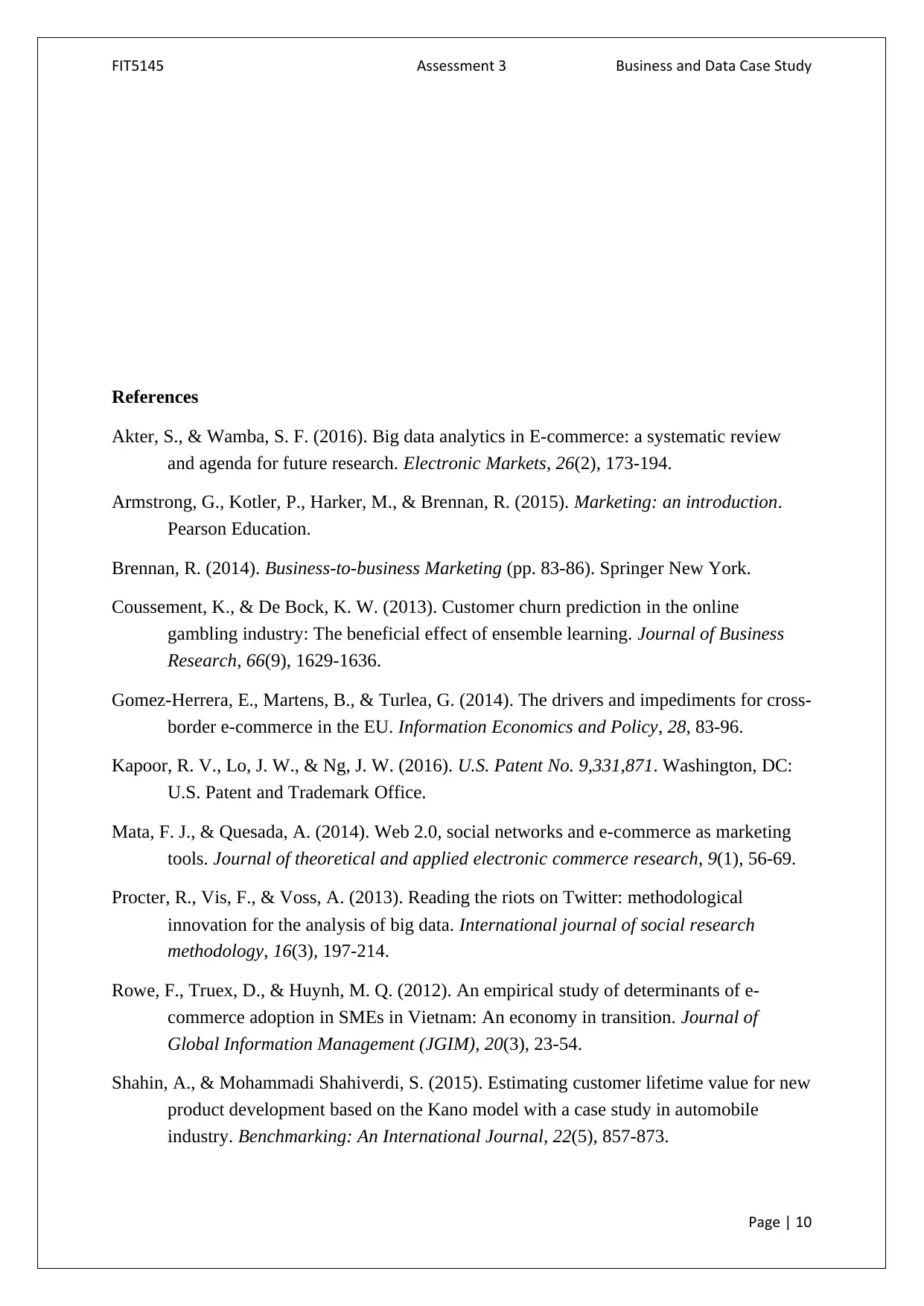
FIT5145 Assessment 3 Business and Data Case Study
References
Akter, S., & Wamba, S. F. (2016). Big data analytics in E-commerce: a systematic review
and agenda for future research. Electronic Markets, 26(2), 173-194.
Armstrong, G., Kotler, P., Harker, M., & Brennan, R. (2015). Marketing: an introduction.
Pearson Education.
Brennan, R. (2014). Business-to-business Marketing (pp. 83-86). Springer New York.
Coussement, K., & De Bock, K. W. (2013). Customer churn prediction in the online
gambling industry: The beneficial effect of ensemble learning. Journal of Business
Research, 66(9), 1629-1636.
Gomez-Herrera, E., Martens, B., & Turlea, G. (2014). The drivers and impediments for cross-
border e-commerce in the EU. Information Economics and Policy, 28, 83-96.
Kapoor, R. V., Lo, J. W., & Ng, J. W. (2016). U.S. Patent No. 9,331,871. Washington, DC:
U.S. Patent and Trademark Office.
Mata, F. J., & Quesada, A. (2014). Web 2.0, social networks and e-commerce as marketing
tools. Journal of theoretical and applied electronic commerce research, 9(1), 56-69.
Procter, R., Vis, F., & Voss, A. (2013). Reading the riots on Twitter: methodological
innovation for the analysis of big data. International journal of social research
methodology, 16(3), 197-214.
Rowe, F., Truex, D., & Huynh, M. Q. (2012). An empirical study of determinants of e-
commerce adoption in SMEs in Vietnam: An economy in transition. Journal of
Global Information Management (JGIM), 20(3), 23-54.
Shahin, A., & Mohammadi Shahiverdi, S. (2015). Estimating customer lifetime value for new
product development based on the Kano model with a case study in automobile
industry. Benchmarking: An International Journal, 22(5), 857-873.
Page | 10
References
Akter, S., & Wamba, S. F. (2016). Big data analytics in E-commerce: a systematic review
and agenda for future research. Electronic Markets, 26(2), 173-194.
Armstrong, G., Kotler, P., Harker, M., & Brennan, R. (2015). Marketing: an introduction.
Pearson Education.
Brennan, R. (2014). Business-to-business Marketing (pp. 83-86). Springer New York.
Coussement, K., & De Bock, K. W. (2013). Customer churn prediction in the online
gambling industry: The beneficial effect of ensemble learning. Journal of Business
Research, 66(9), 1629-1636.
Gomez-Herrera, E., Martens, B., & Turlea, G. (2014). The drivers and impediments for cross-
border e-commerce in the EU. Information Economics and Policy, 28, 83-96.
Kapoor, R. V., Lo, J. W., & Ng, J. W. (2016). U.S. Patent No. 9,331,871. Washington, DC:
U.S. Patent and Trademark Office.
Mata, F. J., & Quesada, A. (2014). Web 2.0, social networks and e-commerce as marketing
tools. Journal of theoretical and applied electronic commerce research, 9(1), 56-69.
Procter, R., Vis, F., & Voss, A. (2013). Reading the riots on Twitter: methodological
innovation for the analysis of big data. International journal of social research
methodology, 16(3), 197-214.
Rowe, F., Truex, D., & Huynh, M. Q. (2012). An empirical study of determinants of e-
commerce adoption in SMEs in Vietnam: An economy in transition. Journal of
Global Information Management (JGIM), 20(3), 23-54.
Shahin, A., & Mohammadi Shahiverdi, S. (2015). Estimating customer lifetime value for new
product development based on the Kano model with a case study in automobile
industry. Benchmarking: An International Journal, 22(5), 857-873.
Page | 10
Paraphrase This Document
Need a fresh take? Get an instant paraphrase of this document with our AI Paraphraser
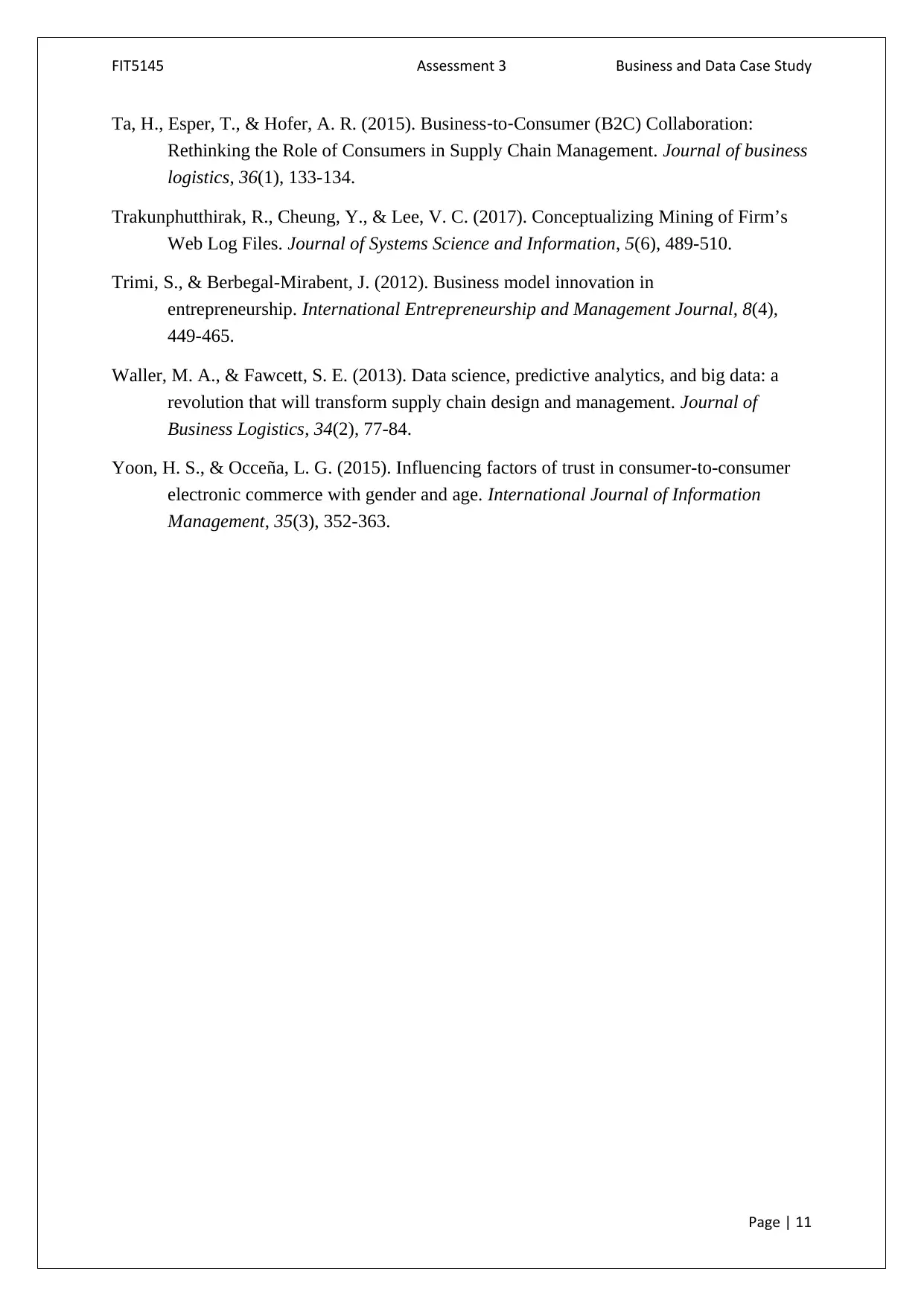
FIT5145 Assessment 3 Business and Data Case Study
Ta, H., Esper, T., & Hofer, A. R. (2015). Business‐to‐Consumer (B2C) Collaboration:
Rethinking the Role of Consumers in Supply Chain Management. Journal of business
logistics, 36(1), 133-134.
Trakunphutthirak, R., Cheung, Y., & Lee, V. C. (2017). Conceptualizing Mining of Firm’s
Web Log Files. Journal of Systems Science and Information, 5(6), 489-510.
Trimi, S., & Berbegal-Mirabent, J. (2012). Business model innovation in
entrepreneurship. International Entrepreneurship and Management Journal, 8(4),
449-465.
Waller, M. A., & Fawcett, S. E. (2013). Data science, predictive analytics, and big data: a
revolution that will transform supply chain design and management. Journal of
Business Logistics, 34(2), 77-84.
Yoon, H. S., & Occeña, L. G. (2015). Influencing factors of trust in consumer-to-consumer
electronic commerce with gender and age. International Journal of Information
Management, 35(3), 352-363.
Page | 11
Ta, H., Esper, T., & Hofer, A. R. (2015). Business‐to‐Consumer (B2C) Collaboration:
Rethinking the Role of Consumers in Supply Chain Management. Journal of business
logistics, 36(1), 133-134.
Trakunphutthirak, R., Cheung, Y., & Lee, V. C. (2017). Conceptualizing Mining of Firm’s
Web Log Files. Journal of Systems Science and Information, 5(6), 489-510.
Trimi, S., & Berbegal-Mirabent, J. (2012). Business model innovation in
entrepreneurship. International Entrepreneurship and Management Journal, 8(4),
449-465.
Waller, M. A., & Fawcett, S. E. (2013). Data science, predictive analytics, and big data: a
revolution that will transform supply chain design and management. Journal of
Business Logistics, 34(2), 77-84.
Yoon, H. S., & Occeña, L. G. (2015). Influencing factors of trust in consumer-to-consumer
electronic commerce with gender and age. International Journal of Information
Management, 35(3), 352-363.
Page | 11
1 out of 11
Related Documents
Your All-in-One AI-Powered Toolkit for Academic Success.
+13062052269
info@desklib.com
Available 24*7 on WhatsApp / Email
![[object Object]](/_next/static/media/star-bottom.7253800d.svg)
Unlock your academic potential
Copyright © 2020–2025 A2Z Services. All Rights Reserved. Developed and managed by ZUCOL.





